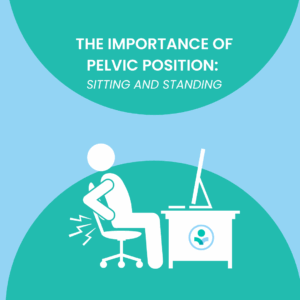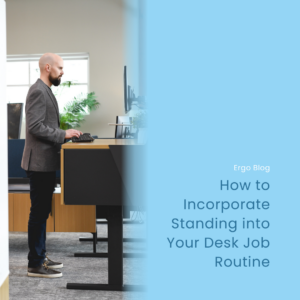Updated: Nov 23, 2022
Creating Healthy Work Routine Habits with a Sit-Stand Desk
If you’ve just upgraded your standard desk to a new height-adjustable standing desk, congrats! You will now be better able to assume a variety of positions throughout your workday, which is a very important aspect of implementing ergonomics into your work environment.
These first few weeks with your new standing desk are the most critical, as you will be working hard to create new habits. At this point, your body is probably used to sitting at a desk for up to seven or eight hours every day. With your new standing desk, you will begin breaking the unhealthy habit of sitting for prolonged periods of time and will begin implementing frequent periods of standing, walking, and stretching into your work routine.
How long should you stand at a height-adjustable desk?
When implementing a height-adjustable desk into your work routine, keep in mind that it is not helpful to totally replace sitting with standing. A height-adjustable desk is meant to encourage movement throughout your workday, not to completely do away with working in a seated position. In fact, when using your height-adjustable desk, you should stand for no longer than 15 minutes per hour.
When we stand, our bodies work hard to keep us upright, because our muscular and skeletal systems are the only things supporting our body weight. To maintain our standing posture, the same muscles are continuously activated, which means they become fatigued much more quickly when we are standing than when we are sitting. This is why you may notice your body weight shifting from side to side more often the longer you stand.
Developing a Good Height-Adjustable Desk Routine at Work
Creating new habits can be challenging, and you will likely find that developing a good height-adjustable desk routine at work is no exception. A height-adjustable desk can be a great addition to your office workspace if you are willing to commit to developing new habits at work. The key to developing these new habits is to create simple goals and to stay consistent in working towards them. Within three to four weeks, you will have your standing desk worked seamlessly into your work routine, and you will be reaping the full ergonomic benefits that come with it. Here are a few tips to get you started with developing a good height-adjustable desk routine at work.
- Take a break from sitting once every hour. If your height-adjustable standing desk is set up properly (link to the previous article), this should be a simple and seamless process. Keep in mind, however, that if you are accustomed to sitting most of your workday, it may be best to slowly incorporate standing into your work routine.
- Set a timer on your computer to remind you to stand once per hour, and start with only 5 minutes of standing at a time. When 5 minutes seems comfortable, add 5 more minutes. Work your way up to a maximum of 15 minutes of standing per hour. When the 15 minutes is up, walk or stretch for 1 to 2 minutes longer and then sit down. Repeat this same cycle every hour.
- It’s important to keep in mind, however, that your body knows what it needs. If you find that standing for longer than 5 to 10 minutes at a time is uncomfortable, there is no need to push yourself to stand longer. A small amount of standing still offers greater benefits than no standing at all.
- Practice the 20-8-2 Rule. This rule was created by Dr. Alan Hedge, a professor of ergonomics at Cornell University. It is broken up into three segments. The first segment is sitting for 20 minutes, followed by a second segment of standing for 8 minutes, and then a final segment of stretching or walking for 2 minutes. Then the cycle repeats. The 20-8-2 Rule is extremely helpful when you are learning to incorporate a variety of positions into your workday, which is an important goal of ergonomics.
- Listen to your body. Once you get used to standing, you might find that you no longer need to keep track of time. You will learn to recognize the “alerts” your body gives when it’s time to change positions. Some of these alerts may be muscle fatigue, becoming distracted or fidgety, or just more generally, feeling uncomfortable. An essential part of implementing a height-adjustable desk into your work routine is learning to detect the warning signals your body communicates to you.
Check out our YouTube video below for a visual representation of the blog!



